Lenovo ThinkPad 10 review: a good Windows tab hurt by poor battery life
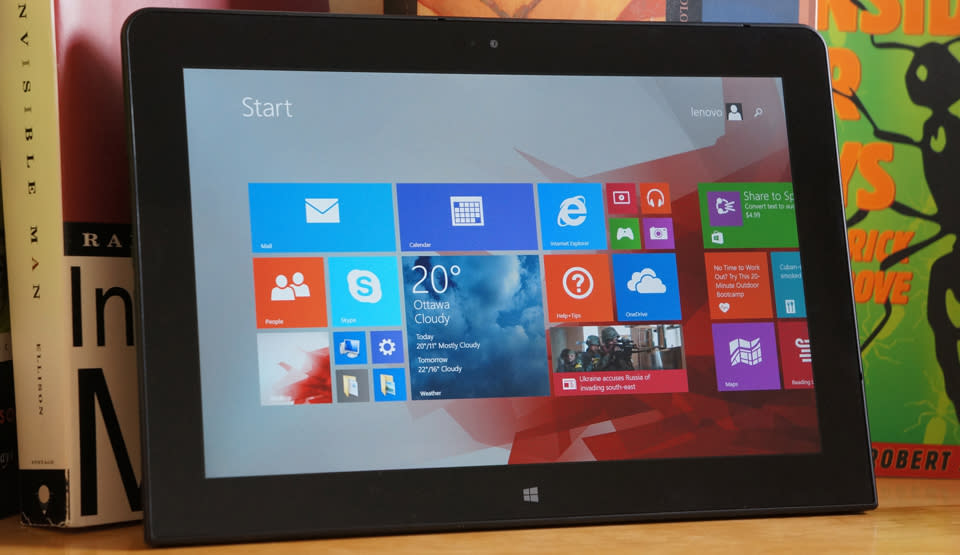
There isn't a very large middle ground in the Windows tablet world right now. You frequently have to choose between a budget-oriented, low-spec model and an expensive portable powerhouse. And that's a shame, really. There are no doubt people who want high-resolution screens or lots of options, but don't want to pay for fast processors that may go to waste. That's what makes Lenovo's ThinkPad 10 so appealing at first glance -- it's a well-equipped 10-inch Windows slate that won't hit your wallet too hard. The question is whether or not it strikes that price-to-performance balance as well as it should. It does in some ways, but there are some big sacrifices involved. Read on to see if they'll be worth your while.
Hardware
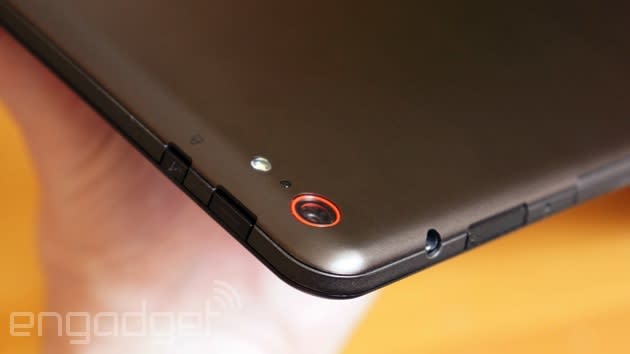
The ThinkPad 10 is no radical departure in design; it mostly looks like the ThinkPad 8 writ large, and it's not even a big deviation from its ThinkPad Tablet 2 ancestor. Not that there's much reason to complain. You're still getting an aluminum-clad machine that's both thin and light (0.35 inch and 1.3 pounds, respectively) and feels every bit as comfortable and well-made as you'd expect for the $599-plus that you'll pay. While that thinness doesn't do any wonders for the battery life, this is definitely the large Windows tablet you want if you regularly compute while standing. It may not be as much of a featherweight as mobile OS-based tablets like the Galaxy Tab S or iPad Air, but it puts noticeably less strain on my wrists than the hefty 1.8 pounds of the larger Surface Pro 3 and Dell's 1.6-pound Venue 11 Pro.
Not that everything is hunky-dory with that metal body. This is the same material and finish you'll find on the ThinkPad 8, so you should expect scuffs and scratches if you forego a case. I was fortunate enough to avoid them during my test run, but I'm notoriously protective of my hardware. And you may never keep it completely pristine. The dark-hued aluminum shows virtually every grimy fingerprint for at least a little while, and there were only so many times that I was willing to wipe them off.
You won't catch me griping much about the layout, which is designed to be used in landscape mode. That's rather wise, given that the ThinkPad may frequently double as a laptop. On the left side, you'll see a covered, full-size USB 2.0 port sitting near both the power connector and a fabric loop that holds the pen (more on that later). Flip over to the right and you'll see micro-HDMI video output, a microSD storage slot, a headphone jack and (if you're in an area where Lenovo sells cellular models) a micro-SIM slot. You'll see both stereo speakers and an 8-megapixel camera with flash on the back, and there's a 2-megapixel shooter on the front. About the only quibbles are the slightly small power button and volume rocker in the upper-right corner, but they're still easy to press. Even the docking connector at the bottom clicks into peripherals with little fuss.
Display, pen and sound
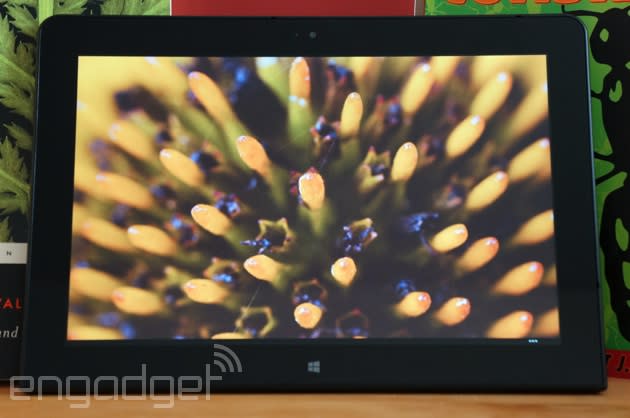
You're more likely to see higher-resolution displays on big tablets, but the ThinkPad 10's LCD still manages to stand out in a pretty crowded space. It's using a taller 1,920 x 1,200 resolution instead of the 1080p screen you're more likely to find at this price point; those extra vertical pixels may not seem like much, but they help when browsing the web or writing a report. The 224 ppi density is also just about right for Windows 8.1, which is finicky about scaling high resolutions to just the right size. The display is sharp enough that content looks good, but it's not so sharp that you're forced to squint or tap lots of tiny buttons when you switch to the traditional desktop.
Crispness isn't the only thing that matters, of course, and the ThinkPad is a bit of a mixed bag in some other areas. I like the IPS-based panel's overall color reproduction, but it's not supremely accurate -- Laptop Mag found that it covers just under 72 percent of the sRGB color gamut, which rules it out for professional photo editing. Viewing angles are very good, however, and I didn't notice color shifts or dimming when looking at the tablet from less-than-natural positions. Just don't plan on taking this device outside on a sunny day. The ThinkPad's LCD is officially rated at 400 nits of brightness and cuts out enough glare to be easily visible in most situations, but it won't overcome direct sunlight.
You may be willing to forgive those foibles given the pen input, which was sadly missing on the ThinkPad 8. You can draw with varying degrees of pressure, or hover above the screen. There aren't any tricks on the level of the Surface Pro 3's OneNote shortcut, but you'll get both a right-click button and an eraser. I found myself liking the pen more than I thought I would -- it's light and comfortable, and I had no trouble with handwriting recognition or doodling. With that said, this is really more of a productivity tool than an artistic instrument. It's hard to apply the exact amount of force you want in a drawing, so you probably won't be producing masterpieces.
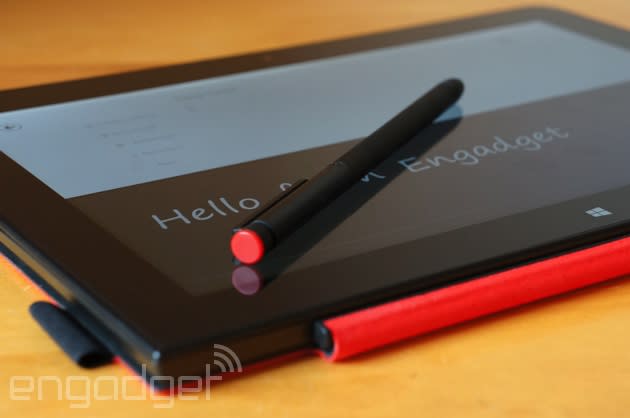
The speakers certainly aren't anything to write home about. They're clear-sounding and reasonably loud even with their rear-facing orientation, so you can listen in a room with moderate background noise. However, they don't carry a lot of punch -- watch a dance music video and you'll wonder where all the bass went. That lack of oomph is acceptable given the ThinkPad's emphasis on pro users, but it would be nice if Lenovo kicked up the quality a notch. Pointing the speakers toward the user's face would help, too.
Software
Just like its smaller sibling, the ThinkPad 10 doesn't carry much in the way of non-standard software, and what's there is (mostly) useful. AccuWeather, Evernote Touch, Hightail (formerly YouSendIt), Norton Internet Security and Zinio's magazine reader are all third-party apps that you can easily use every day. I was most fond of AccuWeather and Evernote, but I could do without Norton's occasional nagging. Don't assume that this is just a carbon copy of the layout from before, though. Lenovo clearly sees its 10-incher as a content-creation station, and has ditched media apps like Kindle and Rara in favor of more serious tools like its self-branded photo and video editors. My one real gripe is the trial-only copy of Office. Unless you prefer alternatives like Google's cloud apps, you'll have to fork out additional cash if you're going to churn out a lot of reports and spreadsheets while on the road.
Performance and battery life
Tablet | PCMark7 | 3DMark06 | 3DMark11 | ATTO (top disk speeds) |
|---|---|---|---|---|
Lenovo ThinkPad 10 (1.59GHz Intel Atom Z3795, Intel HD graphics) | 2,328 | 1,168 | E235 / P155 | 129 MB/s (reads); 52 MB/s (writes) |
Lenovo ThinkPad 8 (1.46GHz Intel Atom Z3770, Intel HD graphics) | 2,567 | 1,598 | E312 / P198 | 128 MB/s (reads); 57 MB/s (writes) |
Acer Iconia W4 (1.33GHz Intel Atom Z3740, Intel HD graphics) | 2,538 | 2,089 | E340 / P211 | 173 MB/s (reads); 48 MB/s (writes) |
ASUS Transformer Book T100 (1.33GHz Intel Atom Z3740, Intel HD graphics) | 2,461 | 2,113 | E338 / P209 | 123 MB/s (reads); 58 MB/s (writes) |
Dell Venue 8 Pro (1.33GHz Intel Atom Z3740D, Intel HD graphics) | 2,343 | 1,986 | E299 / P164 | 86 MB/s (reads); 45 MB/s (writes) |
The ThinkPad 10's performance is a real head-scratcher. On paper, its quad-core 1.6GHz Atom processor should make it one of the fastest Windows tablets in its class. In practice, however, it's relatively pokey; its average benchmark scores were the lowest among the Windows slates we've tried, even when stacked up against older devices with 1.33GHz chips. You can't blame this on the high-resolution display, either, since the equally sharp-looking ThinkPad 8 is still faster. Synthetic tests aren't the be-all and end-all of a device, but it's apparent that the higher clock speed won't grant you any additional bragging rights.
That's true in the real world, too. Like every other recent Atom tablet, this bigger ThinkPad has no trouble whipping through the Windows 8.1 interface and typical apps like browsers or Evernote, but it won't replace a desktop or a good laptop; it's not up to handling serious creative work or high-end games. It's also slow to boot at about 14 seconds (versus eight for Acer's Iconia W4), and the back can get noticeably hot when you're playing action-heavy games like Halo: Spartan Assault. Lenovo isn't pitching the ThinkPad 10 as a speed demon in the first place, but it would be nice to see some tangible improvements for the money, you know? The 2GB of RAM is good enough for common tasks, although I'd strongly recommend buying the top-tier 4GB variant if you're going to juggle many apps at once.
Tablet | Battery Life |
|---|---|
Lenovo ThinkPad 10 | 6:44 |
Microsoft Surface 2 | 14:22 |
iPad Air | 13:45 (LTE) |
Apple iPad mini | 12:43 (WiFi) |
Samsung Galaxy Tab S (10-inch) | 12:30 |
Samsung Galaxy Tab S (8-inch) | 12:22 |
Apple iPad mini with Retina display | 11:55 (LTE) |
Apple iPad (late 2012) | 11:08 (WiFi) |
ASUS Transformer Book T100 | 10:40 |
Apple iPad 2 | 10:26 |
Samsung Galaxy Note Pro 12.2 | 10:04 |
Apple iPad (2012) | 9:52 (HSPA) / 9:37 (LTE) |
Acer Iconia W4 | 9:50 |
Nexus 7 (2012) | 9:49 |
Microsoft Surface RT | 9:36 |
Toshiba Encore | 8:45 |
Sony Xperia Tablet Z | 8:40 |
ASUS Transformer Pad TF103C | 8:26 |
Sony Xperia Z2 Tablet | 7:57 |
Nexus 10 | 7:26 |
Dell Venue 8 Pro | 7:19 |
Samsung Galaxy Note 8.0 | 7:18 |
Nexus 7 (2013) | 7:15 |
Samsung Galaxy Tab Pro 8.4 | 7:13 |
Microsoft Surface Pro 3 | 7:08 |
Samsung Galaxy Tab 3 10.1 | 6:55 |
Lenovo ThinkPad 8 | 6:11 |
The real dealbreaker may be the dismal battery life I hinted at earlier. When looping a 1080p video at half brightness, the ThinkPad 10 musters just six hours and 44 minutes on a charge. That result is better than the bottom-ranked ThinkPad 8, but I'd hardly call that a rousing success. Even when playing a less taxing standard-definition clip, the running time was subpar at seven hours and 38 minutes. No, you won't mind the short lifespan if you're curling up on the couch or taking notes at the occasional meeting, but it's not at all what I'd expect from a business-class tablet that may have to run on battery all day. Frankly, you're better off scooping up something like ASUS' Transformer Book T100 (as old as it is) if every hour counts. What good is a sharper display when you have no power left?
Camera
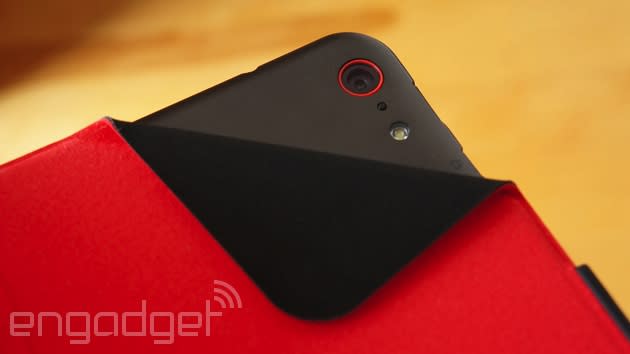
We didn't touch on the cameras when looking at the ThinkPad 8, but it's worth exploring them now -- especially when you're theoretically spending such a hefty sum. The 8-megapixel rear camera is solid, but not spectacular. It's capable of some sharp, colorful pictures in good lighting, including close-ups, but it tends to blow out images in bright lighting, hide detail in shadows and produce plenty of visible noise in darker conditions. The 2-megapixel front cam, meanwhile, is merely adequate for video chat, with noisy, soft pictures. Lenovo does have an ace in the hole, mind you. Its Quickshot Cover will automatically launch the camera app by prying it open, which I found supremely handy for capturing spur-of-the-moment pictures. I wish other tablet makers would follow suit.
Configuration options and the competition
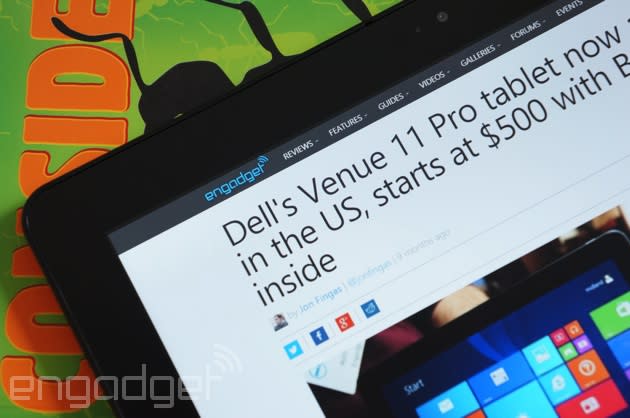
In the US, you have just two ThinkPad models to choose from: the entry-level $599 version with 2GB of RAM and 64GB of storage, and a $699 edition that jumps to 4GB and 128GB, respectively. You'll usually be fine with the starter device if it's just a companion to your main PC, but you'll want to seriously consider the pricier of the two if this is going to be a primary machine. And like many tablets, you'll probably want at least one or two accessories to complete the experience. I would buy the $45 Quickshot Cover without hesitation; besides that camera trick, it's good for protecting the screen or propping the tablet up to watch a movie. If you type often (which is likely if you're already a ThinkPad fan), you should consider spending $90 for the Touch Case or $120 for the Ultrabook Keyboard. I sadly haven't had a chance to try either, but they should serve you better than a third-party Bluetooth keyboard.
The $55 Protector rugged case and $130 Tablet Dock (which adds HDMI, USB 3.0 and Ethernet) are tougher calls. I wouldn't get the Protector unless you're working out in the field and need a drop-resistant shell. Also, the dock partly defeats the point of a tablet. If you're stationary enough to want a larger display, mouse and keyboard, it's likely wiser to get a convertible touchscreen laptop like the Yoga 2 Pro than to go through the hassle of adding all those components after the fact.
It's tricky to find out where the ThinkPad 10 stands among its rivals. As I mentioned earlier, it occupies a rare middle ground in a field that's largely split between affordable Windows slates and high-powered laptop replacements. The most obvious parallel is the Venue 11 Pro, although whether or not it represents a better deal depends on the discounts you get. As of this writing, giving Dell $500 will get you comparable hardware and a full copy of Office; Lenovo's $100 premium does get you a slightly higher pixel count, pen input and a lighter chassis, but those are usually bonuses rather than must-haves. And if you're looking at the $699 ThinkPad, it's hard to resist spending another $100 to get either a high-end Venue 11 Pro or the basic Surface Pro 3. Both have speedier Core i3 processors, and the Surface compensates for its reduced storage with both a 12-inch screen and a more sophisticated pen. If you're going to splurge on a really nice Windows tablet in the first place, doesn't it make sense to get something truly powerful?
Wrap-up
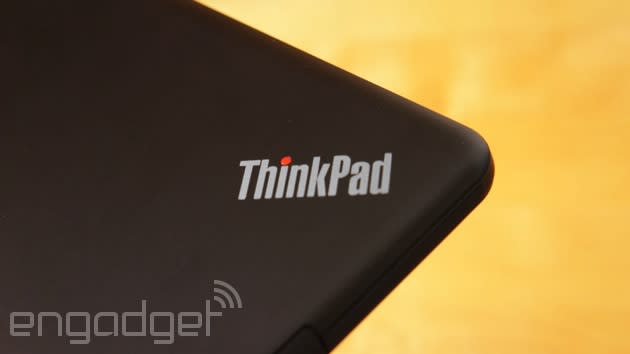
That last point sums up the ThinkPad 10's dilemma, really. You'll undoubtedly get a lot, including that nice display, pen input and top-flight industrial design. However, I can't help but see this as an awkward, in-between product. For the ThinkPad to fit into your world, you need a healthy budget that's not quite so healthy that the highest-end tablets are within reach. This wouldn't be as much of a problem if the device had a long-lasting battery to give it an edge, but it doesn't -- it's actually worse than more powerful hardware where short battery life is expected, like the Surface Pro 3. While I really enjoyed using the ThinkPad, it's more of a specialist's tool than a Swiss Army knife. It's delightful if it fulfills your needs, but you're probably best off either saving money with lower-end tech or investing in something more capable.
Dana Wollman contributed to this review.

































